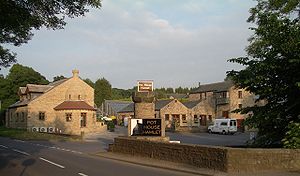
Pot House Hamlet
Encyclopedia
Pot House Hamlet is a historic former industrial site in Silkstone
, South Yorkshire
, England
.
.
Over the door at Pot House, (once a gentleman’s residence) had the letters ”Momento Mori” (remember you must die) A.P.AD 1682” The house was just below Potter Hill where the clay was of suitable quality for pottery and earthen ware. The second main activity was an 18th century Pottery, much pottery was excavated by archaeologists. The pot kilns were fired by Silkstone coal. The Potter John Taylor’s grave is in Silkstone Church yard. He died on 14 July 1815 aged 72 years, his wife Hannah died 13 August 1815 aged 68.
 The third main activity was a mill that used the water from Silkstone Beck to grind grain for the area. The mill was renovated in 2000. The marking of the original water wheel can still be seen on the wall in the “Potting shed”. Pot House was on the Pack Horse Trail which gave access to all over the country. In the 19th and 20th century mining developed, and Silkstone Wagon Way was laid with stone sleepers and supporting rails which carried the coal carts to the canal basin near Cawthorne. The original stones were laid in 1809 and can be seen on the waggon way today down the side of Silkstone Beck next door to the Hamlet. In the 19th century there was also a blacksmith who used to take advantage of the local coal.
The third main activity was a mill that used the water from Silkstone Beck to grind grain for the area. The mill was renovated in 2000. The marking of the original water wheel can still be seen on the wall in the “Potting shed”. Pot House was on the Pack Horse Trail which gave access to all over the country. In the 19th and 20th century mining developed, and Silkstone Wagon Way was laid with stone sleepers and supporting rails which carried the coal carts to the canal basin near Cawthorne. The original stones were laid in 1809 and can be seen on the waggon way today down the side of Silkstone Beck next door to the Hamlet. In the 19th century there was also a blacksmith who used to take advantage of the local coal.
 The fourth main activity was farming. Henry Wallace Horsfield and his family used to farm the land, breed border terriers and raise chickens. He kept pigs in the old mill. In 1961 Wallace gave Tom Horsfield, his son, one thousand roses for his twelfth birthday. Tom went on to grow and breed roses for a living. He exhibited at many shows and indeed won a Gold Medal for his roses at the Great Yorkshire Show. As gardening became ever popular, Tom began to grow trees and shrubs, however still specialising in roses, growing over 350 varieties. His daughter Emma now runs the nursery.
The fourth main activity was farming. Henry Wallace Horsfield and his family used to farm the land, breed border terriers and raise chickens. He kept pigs in the old mill. In 1961 Wallace gave Tom Horsfield, his son, one thousand roses for his twelfth birthday. Tom went on to grow and breed roses for a living. He exhibited at many shows and indeed won a Gold Medal for his roses at the Great Yorkshire Show. As gardening became ever popular, Tom began to grow trees and shrubs, however still specialising in roses, growing over 350 varieties. His daughter Emma now runs the nursery.
Silkstone
Silkstone is a village and civil parish in the Metropolitan Borough of Barnsley in South Yorkshire, England. It is situated in the foothills of the Pennines, between the towns of Barnsley and Penistone, and includes the village of Silkstone Common...
, South Yorkshire
South Yorkshire
South Yorkshire is a metropolitan county in the Yorkshire and the Humber region of England. It has a population of 1.29 million. It consists of four metropolitan boroughs: Barnsley, Doncaster, Rotherham, and City of Sheffield...
, England
England
England is a country that is part of the United Kingdom. It shares land borders with Scotland to the north and Wales to the west; the Irish Sea is to the north west, the Celtic Sea to the south west, with the North Sea to the east and the English Channel to the south separating it from continental...
.
History
A glass works was established at Silkstone around 1659 by John Pilmey, who had emigrated from France some years earlier. The glassworks had two furnaces, one for green glass and the other white. John married Abigail Scott at Silkstone in 1658, later she was one of the signatories who successfully petitioned Parliament against the Glass tax in 1696. Her death is recorded on William Scott’s gravestone in the North Aisle of Silkstone Church. John Warburton in 1718 when preparing his map of Yorkshire noted as he passed Silkstone Church “pass a rill at the bottom the glass house on the right” The remains of the glassworks and pottery were excavated by English Heritage in 2003, and the site was subsequently protected as a Scheduled Ancient MonumentScheduled Ancient Monument
In the United Kingdom, a scheduled monument is a 'nationally important' archaeological site or historic building, given protection against unauthorized change. The various pieces of legislation used for legally protecting heritage assets from damage and destruction are grouped under the term...
.
Over the door at Pot House, (once a gentleman’s residence) had the letters ”Momento Mori” (remember you must die) A.P.AD 1682” The house was just below Potter Hill where the clay was of suitable quality for pottery and earthen ware. The second main activity was an 18th century Pottery, much pottery was excavated by archaeologists. The pot kilns were fired by Silkstone coal. The Potter John Taylor’s grave is in Silkstone Church yard. He died on 14 July 1815 aged 72 years, his wife Hannah died 13 August 1815 aged 68.



